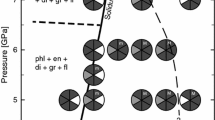Abstract.
A petrogenetic model involving two hydrous minerals is developed in a simple binary system to clarify the nature of melting reactions in presence or absence of a fluid phase. This model shows the changes in shape and location of the solidus in P-T diagrams as a function of the bulk H2O content. The role of divariant equilibria on the beginning and progression of melting is emphasized. In agreement with this model, a generalized scheme for partial melting of metasediments is proposed involving muscovite and biotite as hydrous phases. A P-T projection, a liquidus diagram and its isobaric-isothermal sections are combined in a KN(FM)ASH system. Then, CaO is added as a component and it is demonstrated that the anorthite and grossular components in plagioclase and garnet, respectively, play an important role in the melting of biotite+plagioclase with increasing pressure. The reactions involving these components have large ΔV, low dP/dT slopes and generate S-shaped solidi.
This study shows remarkable analogies in melting behaviour of metapelites, metagreywackes and metabasalts, including the presence of different hydrous minerals at the wet solidus. At intermediate pressures, muscovite (phengite) coexists with biotite in metapelites, and epidote (zoisite) coexists with amphibole in metabasalts. Both pairs of hydrous phases display analogous features: a single volumetrically important hydrous phase (amphibole or biotite) is stable at low pressures, two main hydrous phases are present at intermediate pressures, whereas a single hydrous phase occurs again at higher pressures (zoisite or phengite). Intermediate compositions such as greywackes or andesites may have both pairs of hydrous phases. In most cases, the beginning of fluid-absent melting at pressures above approximately 10 kbar can be attributed to reactions involving muscovite/phengite or epidote/zoisite, two minerals that melt and disappear 150 to 200 °C lower than biotite or amphibole alone, respectively. Rocks that underwent high-pressure metamorphism at moderate temperatures are excellent illustrations of the progressive replacement of a hydrous phase (e.g., biotite) by others (phengite+zoisite), and of the major role of anorthite and grossular components in plagioclase and garnet for phase changes and location of the solidus.
Similar content being viewed by others
Author information
Authors and Affiliations
Additional information
Electronic Publication
Rights and permissions
About this article
Cite this article
, ., , . Melting relations in hydrous systems revisited: application to metapelites, metagreywackes and metabasalts. Contrib Mineral Petrol 141, 251–267 (2001). https://doi.org/10.1007/s004100100237
Received:
Accepted:
Issue Date:
DOI: https://doi.org/10.1007/s004100100237




